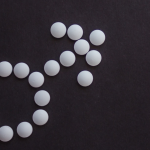Sussanna Czeranko, ND
Past Pearls
“Every hysterical person is a neurasthenic but not every neurasthenic is hysterical.” Otto Juettner, A.M., Sc.M., Ph.D., M.D., 1916
“Stimulants like drugs used for the relief of [neurasthenia] have been invented for both the patient and physician. They relieve the former of obeying the laws of hygiene and the latter of inculcating them.” Albert Abrams, A.M., M.D., 1904
“Now what every [neurasthenic] needs is to be brought in direct touch with the elemental forces. Earth and air, music and flowers, winds and sea and sun, stars and visions and celestial amplitudes; such are the healing agencies to restore one’s poise.” Edward Earle Purinton, M.D., 1908
Just as Dr. Kellogg predicted in 1915, the popular disease neurasthenia eventually disappeared from medical literature. The term ‘neurasthenia’ (nervous exhaustion) was coined in 1869 by Dr. George M. Beard. Kellogg observed that it became a widely recognized disease because “physicians found the new word a convenient name for all sorts of morbid nervous conditions” (Kellogg, 1915, p. 15). In Dr. Henry Lindlahr’s opinion, neurasthenia was “merely a convenient term for covering the doctor’s ignorance” (Lindlahr, 1926, p. 253). In any case, the study of neurasthenia reveals how the passage of time and the advancement of science have changed how we perceive and label a set of symptoms. ‘Nerves’ or nerve exhaustion morphed into ‘neurasthenia’ that evolved into ‘hypoadrenia’ catapulting into ‘stress and burnout’ and back full circle to ‘adrenal exhaustion’. It was not until later that neurasthenia, as a syndrome, would be understood more clearly.
Early on, Abrams cited a “medley of terms” to “specify the varied symptoms” of this catchall word: hypochondriasis, nervousness, brain strain, nervous waste, nervous prostration, nervous exhaustion, nervous breakdown, spinal irritation, etc.” (Abrams, 1904, pp. 15-16). Beard argued that neurasthenia occurred “when people drained their bodies of nervous energy, thereby causing organs to malfunction and allowing any number of symptoms to arise, including indigestion, fatigue, muscle and back pain, impotence, infertility, depression, and irrationality. The exact cause of this drain of energy was not entirely clear” (Schuster, 2003).
Kellogg saw the disease as a “group of symptoms which are not connected with a definite morbid condition, but which may accompany many various morbid states – just as fever with its accompanying headache, rapid pulse, high temperature, hot skin and prostration is not a disease” (Kellogg, 1915, p. 14). Kellogg, who had pursued postgraduate studies under Beard, did not share his mentor’s view that neurasthenia was a distinct disease. Kellogg set out to document methods for patients to help themselves that he had employed successfully with thousands of neurasthenic patients across 40 years. His methods for treating and curing neurasthenia focused on “returning to Nature and in the cultivation of the simple life” (Kellogg, 1915, pp. 22-23).
In post-Civil War America, Schuster explains, the types of people who were susceptible to neurasthenia were “ultracompetitive businessmen and socially active women” (Schuster, 2003). Dr. S. W. Mitchell, a neurologist from Philadelphia, thought both of these groups were unique but unfortunate products of this period in American history.
Neurasthenia was often linked with hysteria, especially in women. Hysteria was defined as “a condition of the nervous system of women, characterized by a suspension or impairment of initiative and willpower and by the dominant influence of imagination or emotion over the sensory and motor functions” (Juettner, 1916, p. 207). Women were inflicted with hysteria while hypochondriasis was “distinctly a disease of men. How did such hysteria present itself in women? Here is one doctor’s description:
Can you picture anything more miserable, more pitiful, than the helpless woman, whose nature has run the gamut of emotions, in the relentless grasp of “Nerves”? – whose tortured brain whirls her up to the dizziest heights of “Hysteria”, almost bordering on madness – powerless to resist- only to plunge her mercilessly into the deepest abyss of ‘Melancholia,’ enveloped in impenetrable grayish green masses of gloom, dejection and despair – until nature mercifully comes to her aid, by allowing her to sink into a comatose condition or deep sleep, from which she eventually emerges – outwardly apparently calm, but a completely exhausted nervous wreck; that’s ‘Nerves’ (Kaim, 1916, p. 351).
Neurasthenia, then, was the label attached to an extensive list of presenting symptoms when the early doctors had no idea what the problems were with their patients. In post-Civil War America, it was fashionable to be diagnosed with neurasthenia, even to the extent that it was also referred to as ‘Americanitis’ by the famous novelist and philosopher, William James. Today, a similar popularity exists with doctors using symptoms of stress and burnout for diagnostic purposes. Generally attributed to overwork by his contemporaries and fellow physicians, Kellogg rarely found overwork to lead to a neurasthenic state. Rather, “overcivilization and useless waste of energy in worry … [would] produce neurasthenia (Kellogg, 1915, p. 17). People breaking Nature’s rules and “acting in opposition to her immutable laws” were cited by Kuhne, a naturopath from Leipzig, as the blame for nervous diseases such as neurasthenia (Kuhne, 1892, p.160). Summers concluded later that “the greatest factor in the cause of the majority of nervous breakdowns, is the fact that the average business man lives in a state of tension, i.e., he does not relax … To live in a continual state of tension is one of the surest ways to break down the resistance of the body” (Summers, 1920, p. 241). One keynote was the symptom of fatigue common in neurasthenia that was not alleviated by rest or sleep.
In our modern clinical practices we encounter daily cases of patients suffering from stress. For example, we have gained many tools to recognize adrenal exhaustion and the effects of stress upon our patients. One hundred years ago, though, stress wasn’t part of the diagnostic lexicon. Rather neurasthenia, as the precursor to stress, dominated the medical landscape in the late 19th and early 20th centuries. It would be half a century before Hans Seyle would write his landmark book, The Stress of Life (Seyle, 1956), and change forever the perception and understanding of stress. Seyle was the first researcher known to have studied stress and to link it specifically with illness. It had only been two decades earlier that the anatomy and physiology of the effects of stress had been developed when Henry Harrower presented his work on endocrinology (Harrower, 1933).
Harrower saw that the symptoms of “the run-down neurasthenic patient practically always [included] dyscrinism, even though it may not stand out above all the other symptoms” (Harrower, 1933, p. 515). Taken from the 1939 American Pocket Medical Dictionary, dyscrinism means any disorder of the endocrine glands. This observation helps explain why neurasthenia attracted a host of varying presentations and names, such as “sexual neurasthenia, congestive neurasthenia, uric acid neurasthenia, auto-toxemic, abdominal (dyspepsia and neurasthenia), and splanchnic” (Ahrams, 1904, p. 39). In turn, this medley of possibilities reinforced Lindlahr’s critical assessment of the competency of medical doctors in their diagnostic skills.
Harrower noted too that overstimulation of the endocrine glands, such as the adrenals, caused depletion resulting in hypoadrenia. A prominent London neurologist, S.A. Kinnier Wilson remarked, “many of the common symptoms of neurasthenia and hysteria are … of sympathetic origin.” He added that it was “difficult to avoid the conclusion that defect of glandular function is responsible for much of the clinical picture of neurasthenia.” Sympathetic tone, he added, “is dependent upon adrenal support, and until the glandular equilibrium is … attained, sympathetic symptoms are liable to occur” (Wilson, 1913, p. 1257). Harrower deduced that emotional overstimulation was the primary cause of adrenal irritation that later resulted in adrenal insufficiency. He comments, “when the ordinary symptoms of hypoadrenia are enumerated, it will be apparent that there is some intimate relationship between this condition and neurasthenia, for the symptoms of both manifestations are practically identical” (Harrower, 1933, p. 516).
A related conversation in the literature of the early naturopathic doctors centered on the concept of autointoxication and morbid matter. Neurologists and the new discipline of endocrinology also embraced these. The literature often alluded to neurasenthics who presented with symptoms of atony of the alimentary tract and circulatory stasis with low blood pressure, adding that they often exhibit autointoxication. Harrower noted,
“the picture of depletion and asthenia, with hyposphyxia (circulatory stasis, cold extremities, low blood pressure) subnormal temperature, reduced tone, and a typical rundown state, [was] one of the most common clinical findings. It accompanies toxemias, acute or chronic; it is a peculiarly marked feature of the postinfluenzal let-down; it is an integral part of the nervous breakdown; it is a part of the convalescent syndrome” (Harrower, 1933, p. 268).
Add all of these parts and the neurasthenic patient has manifested “a thyro-adrenal syndrome of insufficiency” (Harrower, 1933, pp. 516-517).
Even though the cycle of terminology and the diagnostic lexicon developed alongside biomedical research, the new field of endocrinology was not immediately absorbed into the medical thinking with certitude. By 1951, Dr. Bernard Detmar was able to state, “today, there can no longer be any doubt that the activity of the ductless glands is essential to life” (Detmar, 1951, p. 20). He added, “a disturbance in hormone activity always makes itself felt in the form of some nervous disorder. It is therefore permissible to place disorders of a nervous nature largely on the same level as disorders of the endocrine glands. Certain it is that one never appears without the other. … Both ultimately arise from a common cause, which is diminished vital energy” (Detmar, 1951, p. 21).
Many years earlier Kellogg outlined his hypothesis for the etiology of neurasthenia in his landmark book, Neurasthenia. Based on his clinical observations, overwork was rarely the cause. Kellogg listed worry, insomnia, prolonged and excessive brain activity, sedentary life, and chronic toxemia resulting in chronic constipation (Kellogg, 1915, pp. 39-55). He postulated that “insufficiency of sleep, or sleep in a hot, unventilated room or amid noise or other unfavorable conditions, may easily become a cause of neurasthenia” (Kellogg, 1915, p. 40). His contemporary, A.C. Biggs, observed, “nearly every case of neurasthenia presents some form of toxemia. Intestinal autointoxication frequently exists… often in conjunction with … hepatic insufficiency” (Biggs, 1916, p. 217). Kellogg further contended, “the headache and other discomforts arising from constipation, and the promptness with which the unpleasant symptoms are relieved by a thorough bowel movement, afford evidence of the influence of intestinal poisons in producing neurasthenic symptoms” (Kellogg, 1915, p. 60). Kellogg continues, “how strange that so little attention is given the condition of the bowels in adults and that headaches, languor, nervousness and other distresses should be attributed to a multitude of vague and occult causes, when so very tangible and sufficient a cause as a colon filled with putrefying excretions and remnants of undigested foodstuffs is so much in evidence!” (Kellogg, 1915, p. 63). Four decades later, Detmar was still agreeing with Kellogg: “exhaustion is usually the end-effect of a false, unnatural way of living” (Detmar, 1951, p.13).
Kellogg described numerous remedial courses to reverse the toxicity contributing to neurasthenia: changing intestinal flora with Bacillus bifidus and increasing bowel activity. Kellogg’s suggestions for increasing bowel activity were: (a) increased bulk of food; (b) free use of fresh fruits and fresh vegetables; (c) regularity in relation to bowel movement; (d) special exercises to strengthen the abdominal muscles; (e) use of enema at 80° F; and (f) use of agar agar. To aid the body in elimination through the skin, Kellogg used light baths, the sun bath and the air bath. The primary purpose of these baths was to stimulate ‘vigorous perspiration’. To avoid depleting the patient entirely of her energy, sweating was limited and concluded by a cold application; either a cold shower, wet sheet rub, the cold towel rub or the salt glow. Biggs suggested,
“when no physiological contraindication exists, the cold shower is of great value in imparting tone to a debilitated nervous system. … For restlessness and sleeplessness, the prolonged warm bath 94-98° F is efficient; the duration of the bath varying from thirty minutes to two hours. The cold sitz bath and ‘water treading’ have been found useful in many cases of melancholia and for relief of various forms of cerebral distress” (Biggs, 1916, p. 219).
Biggs insisted, “the chief virtue of cold applications in neurasthenia is the strengthening of the nervous system and the development of the patient’s will – the awakening of the patient’s Vis” (Biggs, 1916, p.136).
Purinton’s perspective on this treatment, however, warns against cold plunges. He writes, “nervousness is a disorder of the solar plexus, and recovery proceeds through stimulating or soothing or clarifying the emotional brain (Purinton, 1908, p. 184). Purinton felt that the plunges aggravated the neurasthenic sufferer. “Instead, a cold sponge, or a gentle shower, or a modified Kneipp douche or a sitz with water thrown over the body by the bare hands. One most effective method is to stand in a tub of hot water and slowly pour a pail of cold water down the spine, over the shoulders, across the chest, repeating several times or so long as perfect reaction follows” (Purinton, 1908, p. 184). Purinton found that fasting was contraindicated and the “nervous people should learn to eat more, digest more, assimilate more; and work more, exercise more, live more … [because] the neurasthenic … needs a fuller life on all planes” (Purinton, 1908, p. 185).
As a broad approach to treating neurasthenia, Kellogg lists 56 rules for healthful living based on his clinical observations. Some of his suggestions include eating a meat-free diet, avoiding excess protein and dairy, limiting table salt intake, eating only when hungry, developing abdominal muscles with exercises, sleeping 8 hours and avoiding overheating at night, taking a half day off for an outing in the middle of the week, wearing loose, light and porous clothing, and not worrying. He even advocated taking a vacation when one dreams about their work (Kellogg, 1915, pp. 235-258). He warned, “noise is fast becoming a neurotic habit of the American people. … The nervous system constantly compelled to combat with noise, acquires a habitual alertness and abnormal irritability keeps it forever occupied. … That noise has never been defined as public nuisance under the common law or the sanitary code is strange, for it is easy to prove its injury to human health” (Kellogg, 1915, pp. 220-223).
As we can see, our early naturopathic pioneers were acutely aware of presenting conditions linked to nervous exhaustion, stress and fatigue. The case of a 47-year-old male who was brought to the Bilz Sanatorium on July 30th, 1896 by a family member illustrates a classic therapeutic response. It captures the kind of diagnosis common at the time. The patient is described as arriving in a state of absolute apathy.
“He was utterly without energy or willpower to make or carry out a resolution. … He was of a healthy family and had himself always been healthy; he had had to work hard in his life and had suffered much disappointment and vexation in business. He asserted that he had always lived regularly and moderately, but these assertions were corrected by his relations who showed that he had drunk much and smoked to excess. From his exterior he gave the impression of a man of 65: hair and beard were quite gray, his complexion dull, his eyes languid and lusterless; moreover he took no interest in anything whatsoever, so that he hardly replied to the questions which were put to him. The treatment he received consisted of short, cool partial and hip baths, and stimulant Faradic electric baths, walking barefooted, air baths and gymnastic exercises. At first, … he was altogether too apathetic. After a short time, however, his energy so far increased … his apathy disappeared… He held himself straighter and his aged appearance gave place to one more befitting his age. After a six weeks treatment he was so far restored as to show an interest in his profession, a thing he had not done for years, and resumed his work with every appearance of pleasure” (Bilz, 1898, p. 1509).
In the formative years of naturopathic medicine, the guiding principles of Vis Medicatrix Naturae took shape as the foundation upon which naturopathic practitioners relied. In the early 20th century, the human body was understood by its organ systems and for the early naturopath, digestion was pivotal to the assessment and treatment of a multitude of diseases. However, the adrenal glands of the endocrine system which we are so familiar with today, were just beginning to be explored and diseases associated with the endocrine system or the ductless glands were just getting noticed. “Since neurasthenia with other degenerative disorders, is primarily a result of departure from natural or physiologic modes of life, the thing of first importance is an intelligent … return to nature. In other words, a neurasthenic must live the simple life” (Kellogg, 1915, pp. 22-23).
 Dr Sussanna Czeranko, ND, BBE, is a licensed naturopath in Ontario and Oregon. She is currently a faculty member at NCNM conducting historical research in its rare books room. She is applying these studies to the creation and delivery of an ongoing curriculum centered on nature cure, including balneotherapy and climatology. She has just returned from a trip to Eastern Europe studying peloid and carbon dioxide therapies.
Dr Sussanna Czeranko, ND, BBE, is a licensed naturopath in Ontario and Oregon. She is currently a faculty member at NCNM conducting historical research in its rare books room. She is applying these studies to the creation and delivery of an ongoing curriculum centered on nature cure, including balneotherapy and climatology. She has just returned from a trip to Eastern Europe studying peloid and carbon dioxide therapies.
References
Abrams A. The Blues [Splanchnic Neurasthenia] Causes and Cure, E. B. Treat and Company, New York, 1904.
Beard G. Neurasthenia, or Nervous Exhaustion, The Boston Medical and Surgical Journal, 1869.
Biggs AC. Rational Treatment of Neurasthenia, The Naturopath and Herald of Health, Benedict Lust Publishing, New York, Volume XXI, #4, 1916.
Biggs AC. Rational Treatment of Neurasthenia, The Naturopath and Herald of Health, Benedict Lust Publishing, New York, Volume XXIII, #2, 1918.
Bilz FE. The Natural Method of Healing, F. E. Bilz, 1898, New York.
Detmar B. Nervous Disorders and Hysteria, Disease or Character Defect?, Thorsons Publishers Ltd, London, 1951.
Harrower HR. Practical Endocrinology, Pioneer Printing Company, Inc., Glendale, California, 1933.
Juettner O. A Treatise on Naturopathic Practice, Dr. Benedict Lust Publishers, New York, 1916.
Kaim LE. Nerves and NERVES, The Naturopath and Herald of Health, Benedict Lust Publishing, New York, Volume XXI, #5, 1916.
Kuhne L. The New Science of Healing, Louis Kuhne Publishing, Leipsic, Germany, 1892.
Kellogg JH. Neurasthenia or Nervous Exhaustion, Good Health Publishing Co., Battle Creek, Michigan, 1915.
Lindlahr H. Practice of Natural Therapeutics, Seventh Edition, The Lindlahr Publishing Co., Chicago, 1926.
Purinton EE. What Ails Nerves, The Naturopath and Herald of Health, Benedict Lust Publishing, New York, Volume IX, #6, 1908.
Schuster DG. Neurasthenia and a Modernizing America. JAMA. 2003;290:2327-2328.
Seyle H. The Stress of Life, McGraw-Hill Publishing, New York, 1956.
Summers LA. Nature’s Cure for Disease, The Naturopath and Herald of Health, Benedict Lust Publishing, New York, Volume XXV, #5, 1920.
Wilson SAK. The Clinical Importance of the Sympathetic Nervous System, British Medical Journal, June 14, 1913.





